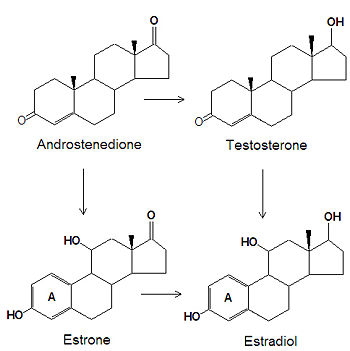Estrogen: Difference between revisions
imported>Pierre-Alain Gouanvic ((earlier edits:) Critical appraisal of the data from the WHI trial) |
imported>Pierre-Alain Gouanvic mNo edit summary |
||
| Line 10: | Line 10: | ||
The increase in cardiovascular mortality observed during the [[Women’s Health Initiative]] trial has led several practicioners to cease recommending hormone replacement therapy to most of their menopausal patients. This might be, in many cases, a misinterpretation of the data. | The increase in cardiovascular mortality observed during the [[Women’s Health Initiative]] trial has led several practicioners to cease recommending hormone replacement therapy to most of their menopausal patients. This might be, in many cases, a misinterpretation of the data. | ||
The results of the trial allow to conclude that it is possible and desirable to initiate HRT in women aged between 50 and 59 if they have vasomotor symptoms, have been menopausal for less than 10 years, are treated with statins, and have a lipid profile and a body weight that are satisfactory. This combination of factors is not rare.<ref name="pmid14645165">{{cite journal |author=Neves-E-Castro M |title=Menopause in crisis post-Women's Health Initiative? A view based on personal clinical experience |journal=Hum. Reprod. |volume=18 |issue=12 |pages=2512–8 |year=2003 |pmid=14645165 |url=http://humrep.oxfordjournals.org/cgi/content/abstract/18/12/2512}}</ref> | The results of the trial allow to conclude that it is possible and desirable to initiate HRT in women aged between 50 and 59 if they have vasomotor symptoms, have been menopausal for less than 10 years, are treated with statins, and have a lipid profile and a body weight that are satisfactory. This combination of factors is not rare.<ref name="pmid14645165">{{cite journal |author=Neves-E-Castro M |title=Menopause in crisis post-Women's Health Initiative? A view based on personal clinical experience |journal=Hum. Reprod. |volume=18 |issue=12 |pages=2512–8 |year=2003 |pmid=14645165 |url=http://humrep.oxfordjournals.org/cgi/content/abstract/18/12/2512}}</ref> | ||
| Line 17: | Line 15: | ||
== 21-hydroxylase deficiency == | == 21-hydroxylase deficiency == | ||
== References == | |||
{{reflist|2}} | |||
Revision as of 02:26, 2 January 2008
An estrogen is a type of steroid hormone with eighteen carbons. With increasing age and menopause, the levels of estrogens decrease in women, and estrogen replacement therapy has been used for decades to decrease the systoms associated with menopause. However, recent studies suggest that estrogen replacement therapy increases the risks of heart attacks and strokes, so its use is now declining. The steroids estrone and estradiol are both estrogens.
Biosynthesis
The estrogens are biosynthesized, by several chemical modifications of androgens. The C-3 ketone group is reduced to an alcohol, the C-19 methyl group is removed and the "A" ring (see steroid for numbering and nomenclature) becomes an aromatic ring.
Estrogen replacement therapy (ERT)
The increase in cardiovascular mortality observed during the Women’s Health Initiative trial has led several practicioners to cease recommending hormone replacement therapy to most of their menopausal patients. This might be, in many cases, a misinterpretation of the data.
The results of the trial allow to conclude that it is possible and desirable to initiate HRT in women aged between 50 and 59 if they have vasomotor symptoms, have been menopausal for less than 10 years, are treated with statins, and have a lipid profile and a body weight that are satisfactory. This combination of factors is not rare.[1]
In addition, the adverse outcomes seen in the WHI trial are not necessarily direct consequences of the treatment, but can result from an exacerbation by estrogen and progestogen of other abnormalities associated with menopause, aging or other factors. Seelig & al have explained how the grossly abnormal calcium:magnesium ratio seen in most of the women who participated to the trial (and most age-matched women in the USA, for instance) likely caused the adverse events; estrogen function depends on normal tissue magnesium concentrations and calcium:magnesium ratios.[2]
21-hydroxylase deficiency
References
- ↑ Neves-E-Castro M (2003). "Menopause in crisis post-Women's Health Initiative? A view based on personal clinical experience". Hum. Reprod. 18 (12): 2512–8. PMID 14645165.
- ↑ Seelig MS, Altura BM, Altura BT (2004). "Benefits and risks of sex hormone replacement in postmenopausal women". J Am Coll Nutr 23 (5): 482S–496S. PMID 15466949.
